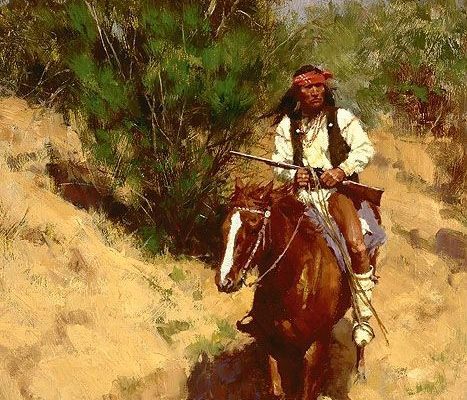The standard myth of the Amerindian was that he was of one monolithic racial group, road a horse, had an all-meat diet, was the best light horsemen in military history, and despite all of these savage qualifications, was somehow a non-violent, peace-loving philosopher.
In fact, the major Amerindian racial-language groupings number 9 distinct language families, for about 700 tribal cultures, which were further subdivided along totemic, familial and military lines. The largest and most meaningful subdivision was the Eastern Woodlands folk, consisting of 5 distinct language groupings, having significant European racial elements. Indeed, the term “savage” is based on the term “sylvan” meaning the woods and the savage being who dwell in the forest, and was applied by numerous European ethnographers, who grouped Eastern Woodlands Indians racially with the European forest folk as being of the Transatlantic “Sylvid” race. Savage has derogatory connotations precisely because it was a term used by the city-dwelling and manor-owning class of elite urban intellectuals to describe the perennially despised “rustic” working man and hunter as an inferior type of uncultivated human.
Amerindians were called, in order of chronological use:
- Indians or Indios [a geographic mistake];
- Savages [forest dwellers];
- Heathens [non-Christian];
- Redskins [based on their wearing of red body paint]; and
- But most usually according to their tribal allegiance.
Warfare was the constant natural state of Amerindian life:
- Navaho is Anasazi for “enemy”;
- Apache is Navaho for “enemy”; and
- Comanche is Ute for “against us always.”
Racial hatred at the tribal level was the currency of Amerindian intersectionality.
Every report by first-contact Europeans and by military men, describe the native warriors of the Eastern Woodlands as superior warriors in every way to their European counterparts—which has to mean that they had plenty of practice. One does not roll out of his hammock, eat his all vegetable meal from his renewable resource bowl, and then stride across military history kicking soldiery ass. Modern infantry combat tactics are based in British Light Infantry doctrine developed by English-speaking and racially European Amerindians of the Northeast Forests. In terms of low barbarism – meaning savagery without moral restraint – the Eastern Woodlands Tribes were unique among warrior societies in that rape was strictly taboo. Yet, they reveled in torture every bit as much as the Spanish Inquisition or English common-law or Puritan judges. On the other side of the ledger, Indian tribes across the continent were very reluctant to practice and permit in-group violence.
Once American westward expansion crossed the Mississippi, the forest-settling pioneers found themselves on a vast, alien landscape of open country, haunted by warrior tribes who had adopted the Iberian horse and lived much as the Scythians, Turks or Mongols out of Central Asia. The tribes of the Great Plains were so racially and ethically different from the eastern tribes, tending to slaughter the women and children of their racial enemies rather than adopt them, that by 1891 serious historians were questioning the image of the honorable tribesmen depicted in almost every earlier account of frontier abduction as some form of delusional narrative. Either all the Indian literature before 1860 was a lie or everything after it was a lie, according to monolithic thought police of varying stripes – unless we are talking about radically different societies, and we are. Indians of the Eastern Woodlands were genetically European at least in part, with some tribes being entirely of European stock such as the Westos and Stockbridge Indians and had cultures and even crafts very much of a Celtic or Norse character, including housing. By contrast, Indians west of the woodlands are racially Asiatic and had cultures as similar to Northeast Asia as to the Eastern Woodlands.
So, if we mean savage in the sense it was used, to describe primitive tribal folk living in the forests, than, the Eastern Woodlands fit the mold.
But, of course, our current term savage means only violent and uncouth. In this sense, Indians of the Great Plains were more likely to engage in the following practices than those of the east:
- Deny women a political voice and use wives as beasts of burden-rape women [the Comanche gang raped every woman they captured];
- Live in filth [the Comanche were every bit as filthy as the Mongols];
- Slay enemy women; and
- Slay enemy children.

In the following ways tribes of the two major types were virtually identical in terms of their difference from European sensibilities:
- Prohibiting in-group violence and bondage, where European culture extolled same-race, in-group and even same-family violence and bondage as the very basis for ethical and economic life;
- Regarded torture of admired enemies as just and good, where the class solidarity of European warriors [officers] prohibited torture of captives even as the beating and killing of soldiers by officers was commonplace-were willing to adopt racial outsiders as full members, which was resisted in European American society until the late 1900s; and
- Always willing to side with Europeans and European Americans against their tribal enemies, [generally taking the side of racial aliens against racial cousins] where European Americans were far more fickle about the military expression of their racial hatreds and national rivalries. [1]
Essentially, the most savage of tribes were the Comanche, who fought other tribes with genocidal fervor and had the social ethics of outlaw bikers.
By contrast, the most civilized and politically advanced tribes, the five and later six nations of the Five-fire-council, known also as the Iroquois [long-house-people] pioneered a political system which served as an inspiration for the Founders of the United States and whose women held real political power. Even they, like their distant Comanche cousins, were, like many tribal folk, fond of genocide and committed numerous human extinction events.
Notes-1. This is a big subject with a lot of exceptions. For instance, the Spanish used tribes in Florida against the English but then invited Americans into Texas to serve as a buffer against the Comanche menace.

James is a full-time writer, part-time coach and part-time wage slave with an extensive history of brain trauma. Check out: http://www.jameslafond.com/




Interesting article